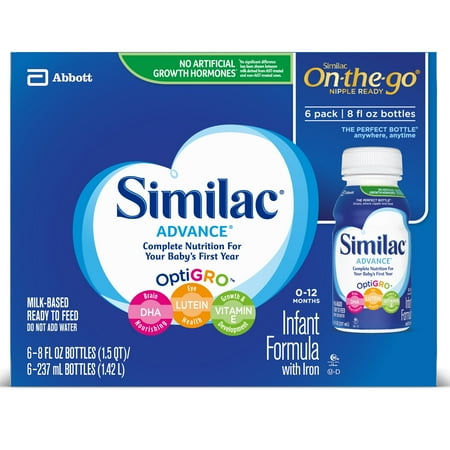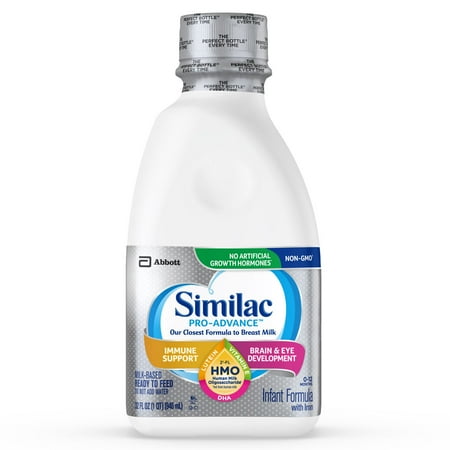Similac Pro-Advance Infant Formula with 2′-FL Human Milk Oligosaccharide (HMO) for Immune Support, Ready to Feed, 8 fl oz bottles, 6 count
Similac Pro-Advance with 2’-FL human milk oligosaccharide* provides immune support by encouraging immune cells to release protective proteins in amounts more like the breastfed baby. It’s also the first leading infant formula with no artificial growth hormones. Parents reported a reduction in fussiness, gassiness, crying, and spit-up after just 1 day of feeding, and the improvement was maintained while feeding the formula. Our exclusive blend of DHA, Lutein, and Vitamin E is important for helping support baby’s brain and eye development. You can trust Similac, the #1 infant formula brand chosen by mom’s and the #1 brand fed in hospitals. *Not from human milk.No significant difference has been shown between milk derived from rbST-treated and non-rbST-treated cows. After switching to Similac Pro-Advance. Total US infant formula, all outlets as of 3/31/2018, Nielsen data|in select stores, The SNAP (Supplemental Nutrition Assurance Program) name is a service mark of the U.S. Department of Agriculture. USDA does not endorse any goods, services, or enterprises.










#1 BRAND FOR IMMUNE SUPPORT*: Similac Pro-Advance is the first infant formula with 2’ FL HMO** designed to be closer than ever to breast milk. (*Based on Pediatrician Recommendations & IQVIA ProVoice Survey 12 months ending February 2020; **not from human milk)NO ARTIFICIAL GROWTH HORMONES: Similac is the first leading infant formula brand with no artificial growth hormones (No significant difference has been shown between milk derived from rbST-treated and non-rbST-treated cows)REDUCED FUSSINESS: Parents reported reduced fussiness, gassiness, and spit-up after 1 day (After switching to Similac Pro-Advance)TRUSTED: Similac is the #1 infant formula brand chosen by moms* and the #1 brand fed in hospitals (*total US infant formula all outlets as of 3/31/18, Nielsen data)BRAIN & EYE DEVELOPMENT: Our exclusive blend of DHA, Lutein, and Vitamin E – nutrients also found in breast milk – helps support baby’s overall growth and brain and eye developmentAccepting SNAP EBT on Grocery Pick Up for this Item





Reviews
There are no reviews yet.